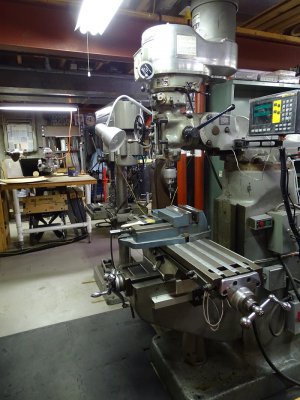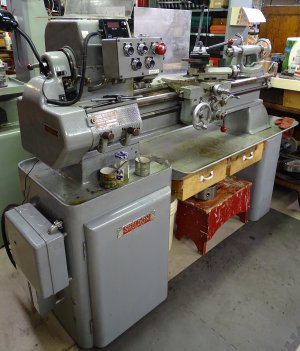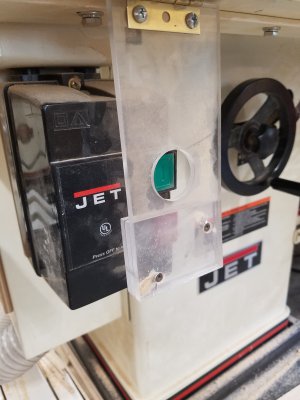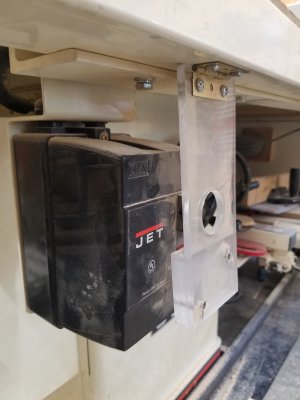- Joined
- Feb 13, 2017
- Messages
- 2,138
graham-xrf provides a very detailed and very good description on how a "small" motor does what it does. I would disagree with a few points but those would be technical and largely a difference in US vs UK electrical systems. Where I would comment here is more a matter of personal preference than an "approved" setup. A "Soft Start" is indeed a nice device, and if you wish to spend the money for one I hope you see the result in your power bill. I'm just not a fanatic of solid state devices when they aren't useful.
The answer you were looking for though can be expressed a little less technically for the (electrical) novice. Like many other small shop machines, the basic ON/OFF function is handled by a simple switch. Usually a "toggle" switch. Folks often use a light switch, though this is not the best idea. Light switches do not have the contacts to handle motor Start/Stop surges. What I describe below is the way my machines are set up. The arrangement is not universal, a "work in progress", as and when I feel like it.
First off, my compressor. 5 HP, single phase, huge inrush. Nominally, 5X run current. I installed a starter with the control circuit consisting of a simple toggle switch and the pressure switch. The concept being that the starter handles the motor current and the pressure switch has only control power. And the ON/OFF switch so I don't have to use the mechanical latch to turn off the compressor.
Next, the table saw, admittedly the most dangerous machine in my shop. I don't do "large" work, like a sheet of plywood. Mostly repetitive work where the fence is set up and I run a number of pieces. I do plywood with a "Skil saw" and "cut-offs" with either a Radial Saw or a Mitre Saw. The table saw NOW has a paddle switch, ON being a push button and off being the "paddle". I would like it to be on a starter, but not willing to spend the money. One day. . .
The point being is that it isn't necessary to remount the starter. Just punch out a KO(Knock Out) and use a Tommy connector to mount the cable. The push button station can mount wherever you want. I would suggest mounting it where you can "swat" the off paddle when you're running. Don't "look and resolve" in an emergency. Just swat it off as you go by.
The answer you were looking for though can be expressed a little less technically for the (electrical) novice. Like many other small shop machines, the basic ON/OFF function is handled by a simple switch. Usually a "toggle" switch. Folks often use a light switch, though this is not the best idea. Light switches do not have the contacts to handle motor Start/Stop surges. What I describe below is the way my machines are set up. The arrangement is not universal, a "work in progress", as and when I feel like it.
First off, my compressor. 5 HP, single phase, huge inrush. Nominally, 5X run current. I installed a starter with the control circuit consisting of a simple toggle switch and the pressure switch. The concept being that the starter handles the motor current and the pressure switch has only control power. And the ON/OFF switch so I don't have to use the mechanical latch to turn off the compressor.
Next, the table saw, admittedly the most dangerous machine in my shop. I don't do "large" work, like a sheet of plywood. Mostly repetitive work where the fence is set up and I run a number of pieces. I do plywood with a "Skil saw" and "cut-offs" with either a Radial Saw or a Mitre Saw. The table saw NOW has a paddle switch, ON being a push button and off being the "paddle". I would like it to be on a starter, but not willing to spend the money. One day. . .
Answer to your question
What you have looks to be a magnetic(electrical) arrangement for Stop/Start. Definitely worth keeping, although it isn't absolutely necessary. Ya got it, USE it. The push buttons will be a "3 wire control" station. Simply stretching the wires to a practical location is all you need. A paddle arrangement can be finagled from a couple pieces of plywood and a hinge. The only advice I can offer is to use a piece of 3 wire cable and a box. Don't use "loose" wires. The push button looks like plastic (insulated), a "ground" wire isn't vital but a good practice. I often buy a heavy 3 wire extensiom some 25 feet long to make line cords. The short cut-offs are a handy source for this sort of work.The point being is that it isn't necessary to remount the starter. Just punch out a KO(Knock Out) and use a Tommy connector to mount the cable. The push button station can mount wherever you want. I would suggest mounting it where you can "swat" the off paddle when you're running. Don't "look and resolve" in an emergency. Just swat it off as you go by.
Bill Hudson









